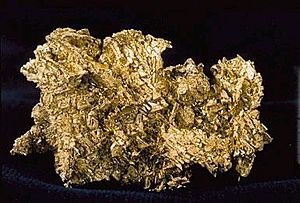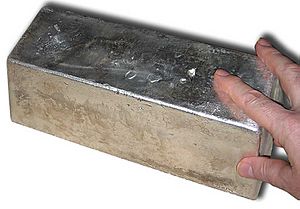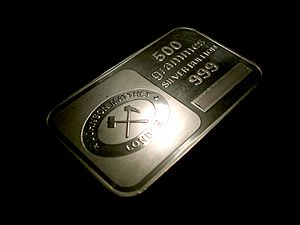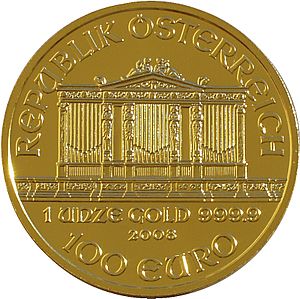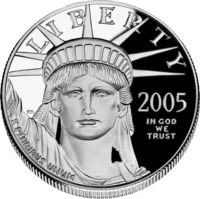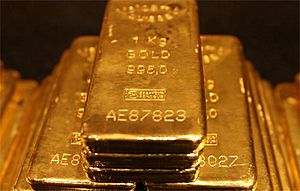Precious metal facts for kids
A precious metal is a special kind of metal that is very rare and found naturally. These metals are worth a lot of money because they are hard to find and have unique qualities.
Chemically, precious metals are not very reactive, meaning they don't easily mix with other elements or rust. They are also usually ductile, which means they can be stretched into thin wires without breaking. They also have a beautiful shine. For a long time, precious metals were used as currency (money). Today, people mostly buy them as investments or use them in industries. Gold, silver, platinum, and palladium are so important that they even have their own special currency codes.
The most famous precious metals are gold and silver. These are often called "coinage metals" because they were used to make coins. While they are used in industries, they are best known for making jewelry, art, and coins. Other important precious metals belong to the platinum group. These include ruthenium, rhodium, palladium, osmium, iridium, and platinum. Platinum is the most commonly traded among these. People want precious metals not just for their practical uses, but also because they are a good way to save money over time. Historically, precious metals have always been much more expensive than common metals.
Contents
What is Bullion?
A metal is called "precious" if it is rare. If new sources of a metal are found, or if it becomes easier to mine and clean it, its value might go down. A metal can also be called "precious" if there is a very high demand for it or if its market value is high. When precious metals are in large, solid forms, like bars or ingots, they are called bullion. Bullion is bought and sold in special commodity markets. Bullion metals can be shaped into ingots (bars) or made into coins. The main thing about bullion is that its value comes from its weight and how pure it is, not from a face value like regular money.
How Pure is Bullion?
The level of purity in bullion can be different. Often, bullion is "three nines" pure, which means it is 99.9% pure. The purest mass-produced bullion coins are the Canadian Gold Maple Leaf coins, which can be 99.999% pure! It's almost impossible to make 100% pure bullion. As you try to get rid of more and more impurities, it becomes much harder to make the metal even purer. In the past, coins often had a mix of metals, called an alloy, and their purity was a local standard. The Krugerrand was one of the first modern coins to be measured in "pure gold." It was designed to contain a specific amount of pure gold. Other bullion coins, like the British Sovereign, don't show their purity or exact gold weight on the coin, but their makeup is well-known and consistent. Many old coins used to show a money value, like the American double eagle which was worth $20.
Bullion Coins
Many countries make special bullion coins. Even though these coins are technically legal tender (official money), their face value (the number printed on them) is much lower than their actual value as bullion. For example, Canada makes a gold bullion coin called the Gold Maple Leaf. It has a face value of $50, but it contains one troy ounce (about 31 grams) of gold. In May 2011, this coin was worth about $1,500 CAD as bullion! When national governments make bullion coins, it gives them some extra value for collectors beyond just their metal value. It also officially confirms how pure they are.
One of the biggest bullion coins ever made was the 10,000-dollar Australian Gold Nugget coin from Australia. It was made of a full kilogram of 99.9% pure gold. In 2012, the Perth Mint in Australia made an even bigger coin: a 1-tonne (1,000 kg) coin of 99.99% pure gold! It had a face value of $1 million AUD, but its gold value was around $50 million AUD, making it the largest coin ever minted. China has also made a few very rare coins (less than 20 pieces) that weigh over 8 kilograms of gold. Austria minted a coin in 2004 that contained 31 kilograms of gold, called the Vienna Philharmonic Coin, with a face value of 100,000 euro. To show off their super pure 99.999% one-ounce Canadian Gold Maple Leaf coins, the Royal Canadian Mint made a 100 kg gold coin in 2007. It had a face value of $1 million. They now make these huge coins to order, but they cost a lot more than just the value of the gold itself.
Why People Invest in Precious Metals
Gold and silver, and sometimes other precious metals, are often seen as a safe place for money. People buy them to protect their savings from inflation (when money loses its buying power) and from economic problems. Silver coins have become popular with collectors because they are more affordable than gold or platinum. Unlike most gold and platinum items, which are valued mainly by the market price of the metal, silver items are often valued much higher as collectibles than their actual metal value.
The Story of Aluminium
A metal that was once precious but became very common is aluminium. Even though aluminium is the third most common element and the most common metal in the Earth's crust, it was incredibly hard to get the pure metal out of its ores (rocks containing the metal). Because it was so expensive to refine, the small amount of pure aluminium available was actually worth more than gold!
At the World's Fair in 1855, bars of aluminium were shown off. Napoleon III, the French emperor, even gave his most important guests cutlery made of aluminium, while less important guests had to use silver. In 1884, the very top of the Washington Monument was capped with a 100-ounce piece of pure aluminium. At that time, aluminium was as expensive as silver. The statue of Anteros on top of the Shaftesbury Memorial Fountain (built between 1885 and 1893) in London's Piccadilly Circus is also made of cast aluminium.
However, over time, the price of aluminium dropped a lot. This happened because of two big changes: the start of commercial electricity production in 1882 and the invention of the Hall–Héroult process in 1886. These made it much easier and cheaper to extract aluminium.
World Market Prices ($/kg)
Here's a table showing how much some precious metals cost per kilogram at different times. The "mass abundance" column shows how rare they are in the Earth's crust (lower number means rarer).
| metal | mass abundance (ppb) |
Valuable metal price (US$/kg) | ||||
|---|---|---|---|---|---|---|
| 10 Apr 2009 |
22 Jul 2009 |
7 Jan 2010 |
31 Dec 2014 |
16 Jul 2018 |
||
| Rhodium | 1 | 39,680 | 46,200 | 88,415 | 39,641 | 77,804 |
| Platinum | 5 | 42,681 | 37,650 | 87,741 | 38,902 | 28,960 |
| Gold | 4 | 31,100 | 30,590 | 24,317 | 38,130 | 43,764 |
| Palladium | 15 | 8,430 | 8,140 | 13,632 | 25,559 | 32,205 |
| Iridium | 1 | 14,100 | 12,960 | 13,117 | 15,432 | 46,940 |
| Osmium | 1.5 | 13,400 | 12,200 | 12,217 | 12,217 | |
| Rhenium | 0.7 | 7,400 | 7,000 | 6,250 | 2,425 | |
| Ruthenium | 1 | 2,290 | 2,730 | 5,562 | 1,865 | 8,423 |
| Germanium | 1,500 | 1,050 | 1038 | |||
| Beryllium | 2,800 | 850 |
||||
| Silver | 75 | 437 | 439 | 588 | 441 | 556 |
| Indium | 50 | 325 | 520 | |||
| Gallium | 19,000 | 580 | 425 | 413 | ||
| Tellurium | 1 | 158.70 | ||||
| Bismuth | 8.5 | 15.40 | 18.19 | |||
| Mercury | 85 | 18.90 | 15.95 | |||
See also
 In Spanish: Metal precioso para niños
In Spanish: Metal precioso para niños


